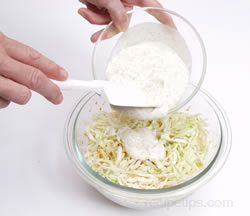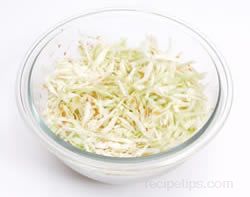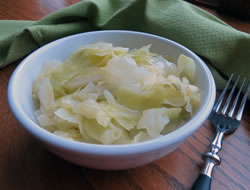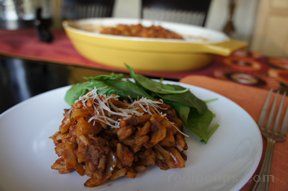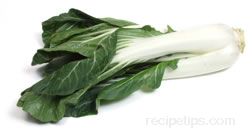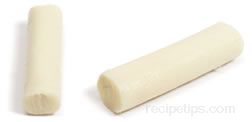|
Cabbage Preparation | Cabbage Cooking | Tips
| Cabbage |
|
  
A vegetable consisting of layers of thick leaves that grow around each other from the stem. The leaves of some varieties form dense, solid heads and others have leaves that grow more loosely around each other. Some varieties have smooth leaves and some have crinkled leaves. Their outer leaves are generally darker green than the inner leaves. Some varieties are dark purplish red and some are white. Among the varieties, savoy with green leaves, Napa, which has pale green to white leaves, red cabbage, and bok choy (Chinese cabbage) with white stems and dark green leaves. Cabbage is a good source of nutrients and contains a fair amount of soluble and insoluble fiber. When cooked, cabbage gives off a very pungent odor. |
|
Uses:
It can be used cooked or raw in dishes from corned beef and cabbage, soups & stews, to cold dishes such as coleslaw. Another popular use of cabbage is to allow it to ferment to produce sauerkraut. Cabbage leaves are also used as a wrap for other foods. |
|
How to Buy: When selecting, choose only the heads that are compact and firm. They should have fresh, crispy leaves that do not contain any markings or browning, which may be an indication of worm damage. The head should only contain a few loose outer leaves. The coloring of the leaves should reflect the variety you are purchasing. In general, the darker green the leaves the more flavor they have. The stem should be trimmed and look fresh, not dry and cracked. Avoid purchasing precut or shredded cabbage. Once the cabbage is cut it begins to lose its vitamin C content, even if it is tightly packaged or well wrapped. |
|
Storage:
Store the cabbage uncut to prevent vitamin C loss. Place the uncut head in a perforated plastic bag and store up to two weeks in the refrigerator crisper drawer. If the cabbage is cut, wrap the remainder of the head tightly in plastic wrap but use within a couple of days. |
| Varieties: |
|
Green Cabbage

|
A cabbage with a firm, dense head with smooth leaves. Its outer leaves vary from pale green to dark green and the inner leaves are white to pale green. It has a mild flavor and crisp texture. This is one of the most commonly found cabbages. |
Red Cabbage
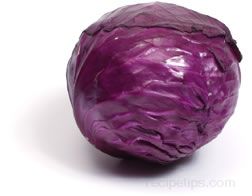 |
A red or purplish cabbage that is more mild and sweet flavored than other cabbage. It has a round, solid head and is popular for adding color to salads, coleslaws and stir-fries. The leaves on the red cabbage are tougher than those on the green cabbage because of its longer maturity time. Red cabbage is available throughout the year. |
|
Savoy Cabbage
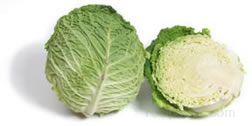 |
A flavorful crinkled leaf cabbage, which is one of the best for cooking. Its head consists of loose leaves, which vary in color from dark green to light green with lacy patterned veins. Its leaves are tender and have a milder, sweeter flavor than the green cabbage. The Savoy Cabbage is considered one of the best but is not always readily available. |
|
Brussels Sprouts

|
A vegetable with small, dense, compact buds that is round and green and is usually no more than 2 inches in diameter. It looks and tastes like a miniature cabbage. It is named after their place of origin, Brussels, Belgium. Usually the smaller sprouts are the best tasting ones. |
Napa Cabbage
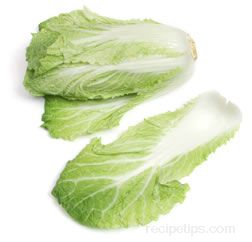 |
A common type of cabbage that provides a mild flavor for a variety of salad and vegetable dishes. High in vitamin C, this cabbage is predominantly grown in Asia and the United States, mainly in California and Hawaii, where it can be grown year round. There are two varieties available for purchase, the "chef" variety and the "Chihili" variety. The chef variety has a tall, more compact, head with many pale green colored leaves. This variety may also be found named Tokyo giant, tropical pride or wintertime. The chihili variety has a very large head, which is more oblong shaped and its leaves are darker green in color. They can be found with the names of market pride, michihili or shaho tsai. Both varieties have fairly large leaves in comparison to other types of cabbage or lettuce. Napa cabbage is used raw in salads and slaws, cooked by boiling or steaming to be eaten on its own, or added to some Asian dishes. It can be used in any recipe that calls for cabbage. You can purchase Napa cabbage throughout the year at most large food stores and specialty produce markets. Napa cabbage is also known as Chinese cabbage, celery cabbage, Peking cabbage, tientsin cabbage, hakusai, pe tsai, or wong bok. |
Bok Choy

Bok Choy - Long White Petiole
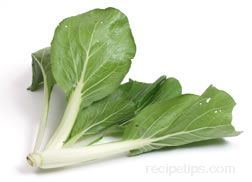
Baby Bok Choy - Small White Petiole |
A type of Chinese vegetable of the mustard family. It has dark green leaves and white celery-like stalks that have a mild, slightly peppery flavor. Both the greens and the stalks are popular in salads and the stalks are often used in stir-fry recipes. It is also known as pak choi, pak choy, Chinese white cabbage, Peking cabbage, celery cabbage, and white mustard cabbage. Bok choy is available throughout the year. When selecting, look for a firm compact head with fresh leaves. If possible, the cabbage should be used when fresh because it does not store well. If it is necessary to store, keep it in the vegetable drawer of the refrigerator, wrapped in plastic. It should stay fresh for a few days if stored properly. | >
Cabbage Preparation
Preparing cabbage basically consist of cleaning and cutting the cabbage to the desired size. When cutting cabbage, a stainless steel knife should be used because if the knife is carbon steel, the cut edges of the cabbage will turn black. The head should not be cut open until it is going to be used because once the cabbage is cut it starts to lose its vitamin C content rapidly. If it is necessary to cut a portion from the head and the remainder will be stored, be sure to wrap the remaining sections tightly in plastic wrap and store in the refrigerator.
Cleaning Cabbage
| Remove the wilted, discolored, and thicker outer leaves. Rinse under cold running water. |
 |
| Cut the cabbage head lengthwise in half and then into wedges (or quarters). If there are signs of worms or insects after the head is cut open, rid the cabbage of them by soaking it in salt water for 20 minutes. |
 |
| Cut the coarse stems from each of the wedges. |
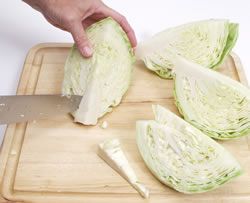 |
| Cabbage with long, loose leaves should have outer discolored or damaged leaves removed but remaining leaves should be left intact with the stem. |
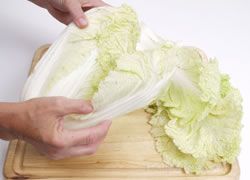 |
Shredding Cabbage
| After the cabbage has been cut into wedges and had the core removed, it can be shredded. To shred by hand, place the wedge with one of the flat sides down. Cut across the wedge in slices of desired thickness. |
 |
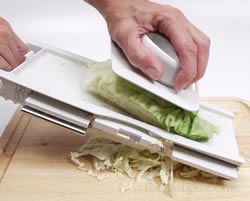 |
 |
| The cabbage can also be cut by the use of a kitchen utensil called a mandoline. The cabbage wedges are slid across the sharp blade located in the middle of the mandoline, which cuts the cabbage into fine shreds. The cabbage can be shred on a clean work surface or some mandolines are designed to sit on the edge of a bowl and the cabbage is shred directly into it. |
| Cabbage with long, loose leaves, such as Nappa cabbage, should have leaves and stem intact and the leaves should be shredded crosswise. |
 |
Cleaning and Preparing Brussels sprouts
| Remove the discolored and blemished outer leaves from the brussels sprouts. |
 |
| Trim the stems so they are level with the head. |
 |
| If the sprouts are going to be cooked whole, cut an X on the stem area. This will allow the sprouts to cook faster and more evenly. |
 |
| The larger sprouts should be cut in half to ensure that they get done cooking at the same time as the smaller whole brussels sprouts. |
 |
Preparing Coleslaw
Cabbage Cooking
Cabbage can be eaten raw or cooked. It can be boiled, steamed, braised, sautéed, stir-fried, and microwaved. It should be cooked until just tender. Overcooking will result in limp, pasty cabbage and produce a very unpleasant smell. The unpleasant smell is caused by the sulfur compounds that are released when the cabbage is cooked too long. Also, older cabbage or those that have been stored for a long time will have a tendency to have even a stronger smell than freshly picked cabbage. Keep the odor to a minimum by cooking uncovered with as little water as possible and cook quickly, do not overcook. Adding a couple thick chunks of bread wrapped in cheesecloth to the cooking water may help to reduce the odor also.
The color in red cabbage will have a tendency to run when it is cooked. The cabbage turns a purplish blue and turns other foods that it is cooked with to a reddish color. To prevent the red cabbage from discoloring, add lemon juice or vinegar to the cooking water. Approximately 1/2 tbsp. per cup of cooking water will be sufficient.
Some common cooking methods for cooking cabbage are shown below.
Boiled Cabbage
| Shred cabbage as shown above. Cabbage should be boiled in just a small amount of water. Add 1/2 to 3/4 inch of water to a saucepan and bring to a boil before adding the cabbage. Add shredded cabbage and cook uncovered. |
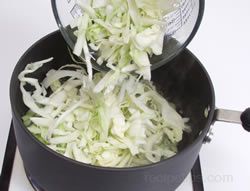 |
| Simmer for 3 to 5 minutes. If cooking wedges, cook for 10 to 15 minutes. Check several times through out cooking time to ensure that the cabbage does not become overcook. Cabbage is done when just tender. |
 |
| When done remove cabbage with a slotted spoon or drain in a colander to remove water. Season as desired and serve while warm. |
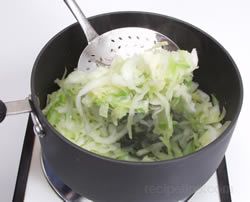 |
Steamed Cabbage
- Add just enough water to a saucepan so that the water will not boil up through the steamer basket when it is placed in the pan.
- Bring the water to a boil.
- Place shredded cabbage or wedges into the steamer basket and place the basket in the pan of boiling water.
- Cover and cook shredded cabbage for 5 to 8 minutes and wedges for 10 to 12 minutes. Cook only until tender-crisp.
- When done, remove steamer basket, season cabbage as desired and serve while warm.
Microwaved Cabbage
- Place shredded cabbage or cabbage wedges in a microwave safe baking dish.
- To cook wedges: add 2 tablespoons of water or broth, and microwave for 5 or 6 minutes.
- To cook shredded cabbage: add 1/4 cup of water or broth per 2 cups of cabbage, and microwave for 5 minutes. Stop halfway through cooking time and stir cabbage. Finish cooking.
- Drain liquid and season as desired. Serve while warm.
Stir-Fried Cabbage
| Heat oil in skillet or wok until hot. Add shredded cabbage to hot oil. |
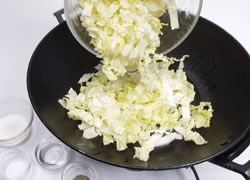 |
| Turn heat to medium and stir-fry cabbage for 2 to 3 minutes. Season with salt, pepper and a little vinegar. Stir constantly until cabbage has cooked to a tender crisp. |
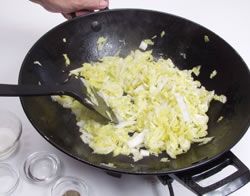 |
| When cabbage is done, it will have cooked to a volume about half of what it was when it was raw. |
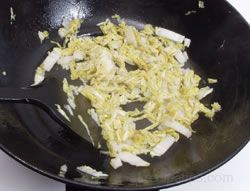 |
Steamed Brussels Sprouts
| Add enough water to the pot so that it is below the bottom of the steamer basket when it is placed in the pot. Bring the water to a full boil using a high heat. |
| Place brussels sprouts in the steamer basket and place the basket in the pot over the boiling water, making sure no water is coming up through the holes in the steamer. Cover sprouts and cook 10 to 12 minutes. |
 |
| Check sprouts before the end of the cooking time to ensure that they do not overcook. Cook the brussels sprouts until they are tender. Remove steamer basket from the pot and serve while hot. |
 |
Boiled Brussels Sprouts
| Fill a saucepan with just enough water to cover the brussels sprouts. Salt the water and bring it to a full boil. Carefully drop the heads into the boiling water and lower the heat to a simmer. |
 |
| Check sprouts before the end of the cooking time to ensure that they do not overcook. Sprouts should be ready in 6-10 minutes. Remove when just tender. |
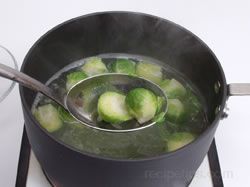 |
Tips
- When cooking red cabbage, prevent the color from running by adding some vinegar or lemon juice to the cooking water.
- To add a different flavor to your sandwich, add shredded cabbage instead of lettuce.
- Add a little red cabbage in with green cabbage to give more color to the salad.
- Rather than shredding the cabbage, cut it into wedges and steam until it is just tender.
- When cooking cabbage, place only ½ to ¾ inch of water in the pan. Too much water will cause the cabbage's color to fade, nutrients and flavor to be lost, and the cabbage to become soggy and limp.
- Do not add any acidic ingredients to the water. Wait to flavor cabbage until cooking is completed.
- For cabbage dishes/salads that are served cold, incorporate enough time into your planning to allow the dish to cool in the refrigerator for at least 1 hour.
- When cabbage is done steaming, cover with melted butter, toasted nuts, minced onion & celery.
|




























